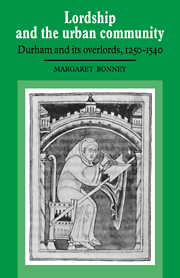Book contents
- Frontmatter
- Contents
- Acknowledgements
- List of abbreviations
- INTRODUCTION
- 1 URBAN ORIGINS: THE GROWTH AND DEVELOPMENT OF DURHAM TO 1250
- 2 THE URBAN LANDSCAPE OF DURHAM 1250–1540
- 3 DURHAM'S MEDIEVAL BUILDINGS
- 4 LANDLORD AND TENANTS: THE ECONOMIC RELATIONSHIP BETWEEN DURHAM PRIORY AND ITS URBAN TENANTS IN THE LATER MIDDLE AGES
- 5 TRADES AND OCCUPATIONS
- 6 LORDSHIP IN ACTION: THE MAINTENANCE OF LAW AND ORDER IN LATE-MEDIEVAL DURHAM
- CONCLUSION: LORDSHIP AND COMMUNITY: THE RELATIONS BETWEEN DURHAM AND ITS ECCLESIASTICAL OVERLORDS IN THE LATER MIDDLE AGES
- Appendix 1 Maps and plans of Durham
- Appendix 2 Tables
- Appendix 3 The dates of the bishops of Durham from 995 to the Dissolution
- Appendix 4 The obedientiaries of Durham Priory
- Appendix 5 The Durham courts
- Bibliography
- Index
INTRODUCTION
Published online by Cambridge University Press: 06 January 2010
- Frontmatter
- Contents
- Acknowledgements
- List of abbreviations
- INTRODUCTION
- 1 URBAN ORIGINS: THE GROWTH AND DEVELOPMENT OF DURHAM TO 1250
- 2 THE URBAN LANDSCAPE OF DURHAM 1250–1540
- 3 DURHAM'S MEDIEVAL BUILDINGS
- 4 LANDLORD AND TENANTS: THE ECONOMIC RELATIONSHIP BETWEEN DURHAM PRIORY AND ITS URBAN TENANTS IN THE LATER MIDDLE AGES
- 5 TRADES AND OCCUPATIONS
- 6 LORDSHIP IN ACTION: THE MAINTENANCE OF LAW AND ORDER IN LATE-MEDIEVAL DURHAM
- CONCLUSION: LORDSHIP AND COMMUNITY: THE RELATIONS BETWEEN DURHAM AND ITS ECCLESIASTICAL OVERLORDS IN THE LATER MIDDLE AGES
- Appendix 1 Maps and plans of Durham
- Appendix 2 Tables
- Appendix 3 The dates of the bishops of Durham from 995 to the Dissolution
- Appendix 4 The obedientiaries of Durham Priory
- Appendix 5 The Durham courts
- Bibliography
- Index
Summary
Many writers have been moved to eloquence by the dramatic site of Durham. The Barnard Castle lawyer, William Hutchinson, writing in the late eighteenth century, remarked on its
elegant situation, and the grandeur of some of its public buildings. A few paces from the south road, this English Zion makes a noble appearance. In the centre, the castle and cathedral crown a very lofty eminence, girt by the two streets called the Baileys, enclosed with the remains of the ancient city walls and skirted with hanging gardens and plantations which descend to the river Were, in this point of view exhibiting the figure of a horse–shoe.
Other writers compared Durham with Jerusalem: ‘he that hath seene the situation of this Citty, hath seene the map of Sion, and may save a Journey to the Jerusalem’. Yet, somewhat surprisingly, Durham has received scant attention from modern historians, perhaps discouraged by remarks such as those made by Professor Hoskins who thought that ‘ we can form almost no idea’ of the economic importance of Durham at the end of the middle ages. Also, as others have commented, it is undoubtedly true that the glamour of the bishops and the cathedral church has often distracted attention away from serious research on the city itself. The present study attempts to remedy this omission, at least in part, by surveying all the surviving documentary, visual and archaeological evidence concerning the urban community.
- Type
- Chapter
- Information
- Lordship and the Urban CommunityDurham and its Overlords, 1250–1540, pp. 1 - 8Publisher: Cambridge University PressPrint publication year: 1990



